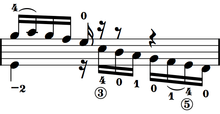Damping (music)


Damping is a technique in music for altering the sound of a musical instrument. Damping methods are used for a number of instruments.
Guitar
On guitar, damping (also referred to as choking) is a technique where, shortly after playing the strings, the sound is reduced by pressing the right hand palm against the strings, right hand damping (including Palm muting), or relaxing the left hand fingers' pressure on the strings, left hand damping (or Left-hand muting). Scratching is where the strings are played while damped, i.e., the strings are damped before playing. The term presumably refers to the clunky sound produced. In funk music this is often done over a sixteenth note pattern with occasional sixteenths undamped.
Floating is the technique where a chord is sustained past a sixteenth note rather than that note being scratched, the term referring to the manner in which the right hand "floats" over the strings rather than continuing to scratch.
Skanking is when a note is isolated by left hand damping of the two strings adjacent to the fully fretted string, producing the desired note (the adjacent strings are scratched). The technique is especially popular among ska, rocksteady and reggae guitarists, who use it with virtually every riddim they play on.
Damping is possible on other string instruments by halting the vibration of the strings using the left hand, similar to on a guitar.[2]
Piano
On a piano, damping is controlled by the sustain pedal and the key dampers, with the strings being damped unless the pedal and/or the respective key is pressed.
Gamelan
Damping is also important in most percussion instruments in the gamelan, including sarons, gendérs, and gangsas. On instruments that are played with a single mallet, the left hand is used to damp the previously hit note when a new note is played. On the gendèr, which is played with mallets in both hands, the keys must be damped by the same hand.
